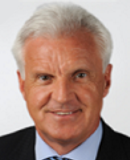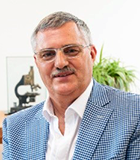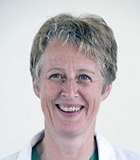André Van Zundert is the former secretary-general and president of the ESRA and a founding member of the ESA. After a career spanning more than 30 years at the Catharina hospital in Eindhoven, The Netherlands, he recently assumed the position of professor and chair at the Department of The Royal Brisbane & Women’s Hospital, Brisbane, University of Queensland, Australia. His academic interest have been as varied as locoregionalanesthesia, airway management, and inhaled anesthetics. André is a true believer in the value of simulation in anesthesia and visualization of anesthetic techniques.
A retired electronic engineer, whom is still active as an advisor in the development of a platform for applied physiology and inhaled pharmacology in anesthesia and ICU applications.
Bart is co-author of several publications in the field of oxygen uptake, quantitative inhalational anesthesia (VA and Xe) and real closed circuit anesthesia.
His first steps in medical technology were made in early 80ties in the Netherlands. Inspired by Prof. R. Serra, his interest in respiratory physiology, in particular the gas exchange and lung mechanics, was initiated.
Prof Erdman recognized the closed system technology as the right direction for real closed applications based on his ideas launched in 1978.
In 1990 the PhysioFlex was launched. The multi center studies required for the approval of the Xenon as a drug were carried out with the PhysioFlex.
Annelies Moerman is Professor at the Department of Anesthesia and Perioperative Medicine at Ghent University, Belgium. Her research has focused on near-infrared spectroscopy, culminating in her 2013 PhD thesis “Clinical application of near-infrared spectroscopy in perioperative assessment of cerebral and peripheral tissue oxygenation” (Ghent University, Belgium). She is associate editor of the European Journal of Anaesthesia and of the Acta Anaesthesiologica Belgica. We look forward to having her chair NAVAt VI.
Ross Kennedy is Clinical Associate Professor at the University of Otago in Christchurch, New Zealand. Out of his interest in low flow and closed circuit anesthesia, he developed his own predictive display of the relationship between fresh gas flows, vaporizer settings, end-expired and effect site partial pressures of inhaled anesthetics, a pharmacokinetic/pharmacodynamic visual display “avant-la-lettre”. His interest in the Navigator was the next logical step, which he addressed at NAVAt II. But he has also been studying patterns in fresh gas flow usage upon introduction of new low flow devices, and has looked into means to encourage anesthesia providers to sustain the use of low fresh gas flows. He will explain “What *you* can learn from your anesthesia machine” using modern data management tools.
Prior to joining Dalhousie University (Halifax, Canada) in 2007, Professor Michael Schmidt was a cardiac anesthesiologist and leader of the Neuroprotect Research Group at the University of Ulm (Germany), which included the study of several aspects of xenon as an anesthetic. He holds appointments in the Department of Anesthesia, Pain Management & Perioperative Medicine, the Department of Physiology and Biophysics, and the School of Biomedical Engineering. His research interests include post-operative neuro-cognitive decline and the development of organ-protective strategies. It is tempting to speculate that his experience with low flow anesthesia to administer xenon and his “exposure” to oxygenators during cardiac anesthesia may have blended into a radical, new design of a type of CO2 absorber that might ultimately eliminate Ca(OH)2 granules as a CO2 absorbent: “No more CO2 absorber canister changes !! From CPB oxygenator to everlasting CO2 absorber”.





